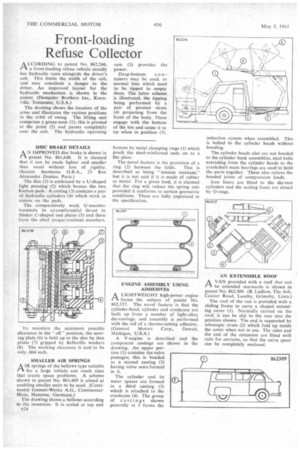Front-loading Refuse Collector
Page 112

If you've noticed an error in this article please click here to report it so we can fix it.
A CCORDING to patent No. 862,246,
a front-loading refuse vehicle usually has hydraulic rams alongside the driver's cab. This limits the width of the cab, and may constitute a danger to the driver. An improved layout for the hydraulic mechanism is shown in the patent. (Dempster Brothers Inc., Knoxville. Tennessee, U.S.A.)
The drawing shows the location of the arms and illustrates the various positions in the orbit of swing. The lifting unit comprises a goose-neck (1); this is pivoted at the point (2) and passes completely over the cab. The hydraulic operating
DISC BRAKE DETAILS
A N IMPROVED disc brake is shown in ri patent No. 861,648. It is claimed that it can be made lighter and smaller than usual without loss of rigidity. (Societe Anonyme D.B.A., 23 Rue Alexandre Dumas, Paris.) The disc (1) is embraced by a U-shaped light pressing (2) which houses the two friction pads. A casting (3) contains a pair of hydraulic cylinders (4) which work in unison on the pads.
The comparatively weak U-member transmits its circumferential thrust to thicker C-shaped end plates (5) and these form the chief torque-resistant members.
To maintain the minimum possible clearance in the "off" position, the moving plate (6) is held up to the disc by thin plates (7) gripped by Belleville washers (8). The working clearance is said to be only .004 inch.
SMALLER AIR SPRINGS
A IR springs of the bellows type suitable for a large vehicle can reach sizes that create space problems. A scheme shown in patent No. 861,469 is aimed at enabling smaller units to be used. (Continental Gummi-Werke A.G., ContinentalHaus, Hanover, Germany.)
The drawing shows a bellows according to the invention. It is sealed at top and e24 bottom by metal clamping rings (1) which pinch the steel-reinforced ends on to a flat plate.
The novel feature is the provision of a
ring (2) between the folds. This is described as being "tension resistant," but it is not said if it is made of rubber or metal. For a given load, it is claimed that the ring will reduce the spring rate provided it conforms to certain geometric conditions These are fully explained in the specification.
r-V A LIGHTWEIGHT high-power engine forms the subject of patent No. 862,337. The novel feature is that the cylinder-head, cylinder and crankcase are built up from a number of light-alloy die-castings, and assembly is performed with the aid of a thermo-setting adhesive. (General Motors Corp., Detroit, Michigan, U.S.A.)
A V-engine is described and the component castings are shown in the drawing. An upper portion (I) contains the valve passages; this is bonded to a second casting (2) having valve seats formed in it.
The cylinder and its water spaces arc formed in a third casting (3) which is attached to the crankcase (4). The group of castings shown generally at 5 forms the induction system when assembled. This is bolted to the cylinder heads without bonding.
The cylinder heads also are not bonded to the cylinder bank assemblies, steel bolts extending from the cylinder heads to the crankshaft main bearings are used to hold the parts together. These also relieve the bonded joints of compression loads.
Iron liners are fitted to the die-cast cylinders and the sealing faces are closed by 0-rings.
AN EXTENSIBLE ROOF
AA VAN provided with a root that can be extended rearwards is shown in patent No. 862,309. (B. Ludlow, The Ash, Caistor Road, Laceby, Grimsby, Lincs.)
The roof of the van is provided with a sliding frame to carry a shaped extending cover (1). Normally carried on the roof, it can be slid to the rear into the position shown. The end is supported by telescopic struts (2) which fold up inside the cover when not in use. The sides and the end of the extension are fitted with rails for curtains, so that the extra space can be completely enclosed.








































































































































































































































































